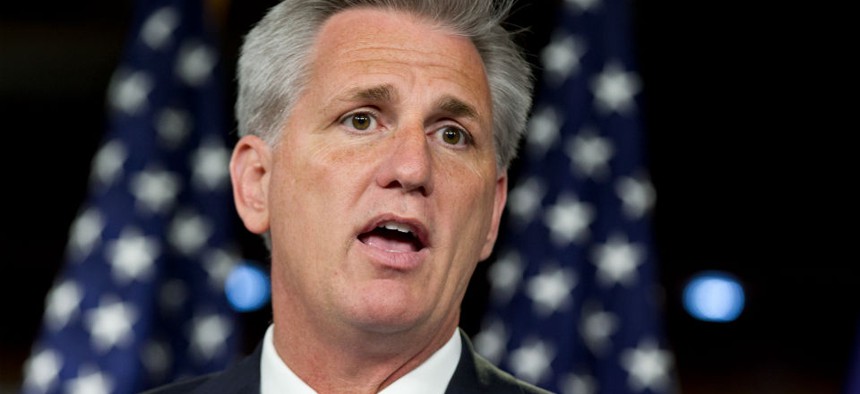
Kevin McCarthy's California district faces ozone woes and his rise to leadership makes him a powerful opponent of the Environmental Protection Agency's new rules. J. Scott Applewhite/AP File Photo
Why Cantor's Downfall Is Bad News for EPA
Loss has put a critic of the agency's smog standards in position to keep fighting them from the top.
The Environmental Protection Agency is already facing a war on multiple fronts as it works to review its smog standards this year. Environmentalists have vowed to fight to get the standards as low as possible to get maximum health benefits, while industry groups have been lining up to fight what they say is the most costly environmental regulation to come out of the administration.
And now Eric Cantor's upset loss has put one of the ozone rule's congressional critics—House Whip and presumed next Majority Leader Kevin McCarthy—in position to keep fighting it from the top.
EPA by December will propose a revision to its regulation for ground-level ozone—or smog—that is linked to asthma and other respiratory problems. It's part of the regular review of its air-quality standards required under the Clean Air Act, and the agency is expected to lower the standard from the 75 parts-per-billion level set under the George W. Bush administration.
The critics have familiar talking points: Compliance will require costly pollution controls and limits on transportation, and a state or region in violation can face heavy fines. Environmentalists, meanwhile, are particularly sensitive to this rule since EPA's last attempt to lower the standard was squashed by the White House in 2011.
McCarthy's concerns are closer to home. His Bakersfield district is located in California's Central Valley, home to some of the worst air in the country. How bad? In the American Lung Association's 2014 State of the Air report, four cities in the valley ranked two through five for the worst ozone quality (the lowest-ranked city, Los Angeles, is just south).
That's largely due to topography. The region is surrounded on three sides by mountains that allows pollutants to pool and get trapped by an inversion layer of hot air. Heavy traffic in the region, coupled with recent economic development and traditional agriculture, means lots of emissions. During hot summer months, the conditions are ideal for dangerous levels of smog.
State officials have worked to mitigate the pollution by placing restrictions on stationary sources, cleaning of diesel fuel, and regulating agriculture, among other efforts. The number of days violating the ozone limits has dropped steadily since 2000. But it's still been an uphill climb for the region to meet federal standards, and McCarthy, along with other representatives of the region, have said a tighter standard will only open the state up to heavy penalties.
In 2011, his first year as whip, McCarthy introduced a bill that would have delayed implementation of new ozone standards until a local advisory committee studied the feasibility of compliance and would have repealed a fine imposed on the Central Valley (the bill was rendered moot when the standard was pulled).
McCarthy also leads the House Energy Action Team, the partnership that promotes GOP energy priorities and works against EPA regulations. The team's mission has included work on the air-quality standards. As a hint of its agenda this term, the group will host a briefing Wednesday on air-quality rules featuring former EPA air chief Jeff Holmstead.
McCarthy also last week—coincidentally the same day as Cantor's defeat—wrote to the EPA about a separate Central Valley air issue. He and five other Central Valley representatives asked the agency to declare an "exceptional event" and spare the state from fines for violating particulate-matter standards because of a months-long drought. The standard is separate from the ozone rule, but speaks to the region's challenges; state regulators had predicted the particulate standards would be met were it not for the drought's impact.
The concern about background ozone—the naturally occurring levels—has grown as a talking point among opponents of a new standard. The American Petroleum Institute, for example, has circulated a map warning that a standard of 60 ppb—likely below what the EPA will propose—would put 94 percent of the country in violation (that map includes wide swaths of rural areas that aren't monitored by EPA).
But environmentalists have said that those concerns are unfounded and that the public-health benefits will outweigh the costs. According to EPA, the standards could avert between 4,000 and 12,000 premature deaths and as many as 111,000 cases of respiratory disease by 2020.
It's too early to know where EPA will go with the ozone standard. The agency's scientific advisory council said in a conference call that it would recommend a limit between 60 and 70 ppb, but cautioned that the upper limit would have a "limited margin of safety" (they have yet to issue a formal letter of recommendation). That's the same range that the advisory board gave EPA in 2010, when the EPA proposed a standard of 70 ppb until the White House stalled the action.
Environmentalists want to see a number lower than 70—in fact some have said that the starting point should be 60 ppb to get the maximum health benefits.
EPA is under a court order to propose a standard by December and finalize it by October 2015, although the agency has said its final action won't be until November of that year. All of which gives McCarthy plenty of time to settle into his office before the standards come across his desk.






